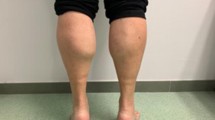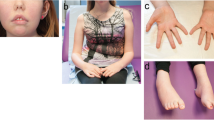Abstract
Lack of the muscle-specific isoform of AMP deaminase (myoadenylate deaminase deficiency) can cause a metabolic myopathy, with exercise-induced muscle symptoms such as early fatigue, cramps and/or myalgia. It is the most common muscle enzyme defect in man, found in about 2-3% of all muscle biopsies. The genetic basis of the inherited defect is the nonsense mutation C34-T in the AMPD1 gene encoding myoadenylate deaminase. The mutation results in a premature stop of the enzyme synthesis. In a healthy German population, the frequency of the mutant allele was 0.1, and 1 % of this population is expected to be homozygous for the mutation. In people with muscle symptoms, the allele frequency was significantly higher (0.145). The correlation between allele frequency and muscle symptoms underscores the clinical significance of this defect. However, the vast majority of homozygous subjects do not develop a metabolic myopathy. This clinical heterogeneity may be due to molecular genetic factors such as alternative splicing of the exon harbouring the mutation, or due to metabolic conditions such as pathways compensating for the defect. The real basis for the high percentage of asymptomatic homozygous subjects remains to be revealed.
Similar content being viewed by others
REFERENCES
Atkinson DE (1968) The energy charge of the adenylate pool as a regulatory parameter. Interaction with feedback modifiers. Biochemistry 7: 4030–4034.
Fishbein WN, Armbrustmacher VW, Griffin JL (1978) Myoadenylate deaminase deficiency: a new disease of muscle. Science 200: 545–548.
Goebel HH, Bardosi A (1987) Myoadenylate deaminase deficiency. Klin Wochenschr 65: 1023–1033.
Gross M (1994) New method for detection of C34-T mutation in the AMPD1 gene causing myoadenylate deaminase deficiency. Ann Rheum Dis 53: 353–354.
Gross M, Kormann B, Kamilli I, Gresser U, Reiter S (1989) Influence of D-ribose administration on the exercise-induced increase in hypoxanthine excretion. Ann Nutr Metab 33: 215–216.
Gross M, Reiter S, Zöllner N (1989) Metabolism of D-ribose administered continuously to healthy persons and to patients with myoadenylate deaminase deficiency. Klin Wochenschr 67: 1205–1213.
Gross M, Kormann B, Zöllner N (1991) Ribose administration during exercise: effects on substrates and products of energy metabolism in healthy subjects and a patient with myoadenylate deaminase deficiency. Klin Wochenschr 69: 151–155.
Gross M, Combe C, Gresser U, Schuster H, Zöllner N (1992) Häufigkeit der für den primären Myoadenylatdeaminase-Mangel verantwortlichen Mutation C34-T (Gln12-Stop) in einer Bevölkerungsstichprobe. Klin Wochenschr 69(Supplement XXIII): 96.
Gross M, Morisaki H, Morisaki T, Holmes EW (1995a) Identification of functional domains in AMPD1 by mutational analysis. Biochem Biophys Res Commun 205: 1010–1017.
Gross M, Ehrmann D, Empl W, Rötzer E (1995b) Clinical relevance of myoadenylate deaminase deficiency. J Mol Med 73: B39.
Joosten E, van Bennekom C, Oerlemans F, De Bruyn C, Oei T, Trijbels J (1984) Myoadenylate deaminase deficiency: an enzyme defect in search of a disease. Adv Exp Med Biol 165A: 85–89.
Lecky BRF (1983) Failure of D-ribose in myoadenylate deaminase deficiency. Lancet 1: 193.
Lowenstein JM (1972) Ammonia production in muscle and other tissues: the purine nucleotide cycle. Physiol Rev 52: 382–414.
Mahnke-Zizelman DK, Sabina RL (1992) Cloning of human AMP deaminase isoform E cDNAs. Evidence for a third AMPD gene exhibiting alternatively spliced 5′-exons. J Biol Chem 267: 20866–20877.
Mercelis R, Martin JJ, de Barsy T, Van de Berghe G (1987) Myoadenylate deaminase deficiency: absence of correlation with exercise intolerance in 452 muscle biopsies. J Neurol 234: 385–389.
Mineo I, Holmes EW (1991) Exon recognition and nucleocytoplasmic partitioning determine AMPD1 alternative transcript production. Mol Cell Biol 11: 5356–5363.
Mineo I, Clarke PRH, Sabina RL, Holmes EW (1990) A noval pathway for alternative splicing: identification of an RNA intermediate that generates an alternative 5′ splice donor site not present in the primary transcript of AMPD1. Mol Cell Biol 10: 5271–5278.
Morisaki T, Gross M, Morisaki H, Pongratz D, Zöllner N, Holmes EW (1992) Molecular basis of AMP deaminase deficiency in skeletal muscle. Proc Natl Acad Sci USA 89: 6457–6461.
Morisaki H, Morisaki T, Newby LK, Holmes EW (1993) Alternative splicing: a mechanism for phenotypic rescue of a common inherited defect. J Clin Invest 91: 2275–2280.
Patten BM (1982) Beneficial effect of D-ribose in patient with myoadenylate deaminase deficiency. Lancet 1: 107.
Reimers CD, Pongratz DE, Gross M, Paetzke I, Zimmer H-G (1988) Symptomatische Therapie des primären Myoadenylat-Deaminase-Mangels sowie der Glykogenose Typ V mit D-Ribose. In Mortier W, Pothmann R, Kunze K, eds. Aktuelle Aspekte neuromuskulärer Erkrankungen. Stuttgart: Thieme, 127–130.
Sabina RL, Swain JL, Patten BM, Ashizawa T, O'Brien WE, Holmes EW (1980) Disruption of the purine nucleotide cycle. A potential explanation for muscle dysfunction in myoadenylate deaminase deficiency. J Clin Invest 66: 1419–1423.
Sabina RL, Swain JL, Holmes EW (1982) Functional and biochemical evidence of the importance of the purine nucleotide cycle in muscle. J Clin Chem Clin Biochem 20: 414.
Sabina RL, Swain JL, Olanow CW, et al (1984) Myoadenylate deaminase deficiency. Functional and metabolic abnormalities associated with disruption of the purine nucleotide cycle. J Clin Invest 73: 720–730.
Sabina RL, Swain JL, Holmes EW (1989) Myoadenylate deaminase deficiency. In Scriver CR, Beaudet AL, Sly WS, Valle D, eds. The Metabolic Basis of Inherited Disease, 6th edn. McGrawHill: New York, 1077–1184.
Sabina RL, Morisaki T, Clarke P, et al (1990) Characterization of the human and rat myoadenylate deaminase genes. J Biol Chem 265: 9423–9433.
Shumate JB (1983) Myoadenylate deaminase deficiency — a nonfamilial, nondisease? Neurology 33: 1533–1534.
Van den Berghe G, Bontemps F, Vincent MF, Van den Bergh F (1992) The purine nucleotide cycle and its molecular defects. Prog Neurobiol 39: 547–561.
Zimmer H-G, Ibel H, Suchner U, Schad H (1984) Ribose intervention in the cardiac pentose phosphate pathway is not species-specific. Science 223: 712–714.
Zöllner N, Reiter S, Gross M, et al (1986) Myoadenylate deaminase deficiency: successful symptomatic therapy by high dose oral administration of ribose. Klin Wochenschr 64: 1281–1290.
Author information
Authors and Affiliations
Rights and permissions
About this article
Cite this article
Gross, M. Clinical heterogeneity and molecular mechanisms in inborn muscle AMP deaminase deficiency. J Inherit Metab Dis 20, 186–192 (1997). https://doi.org/10.1023/A:1005352605421
Issue Date:
DOI: https://doi.org/10.1023/A:1005352605421




